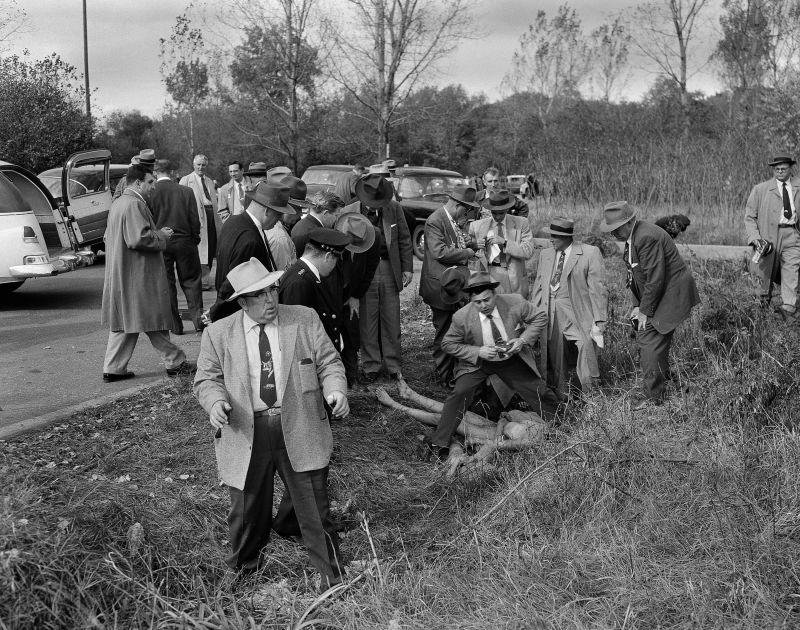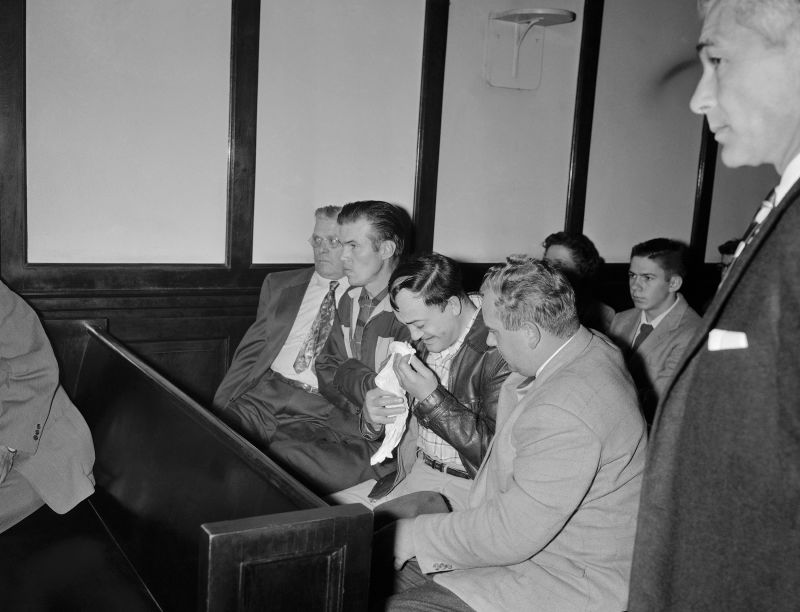I both hate a love reading these things. This one involves evil horse people.
from true crime.i09.com
It was a Sunday in October 1955 when three Chicago boys (from left in the photo: Robert Peterson, 14; John Schuessler, 13; and his brother, Anton, 11) decided to venture downtown for a matinee. Peterson’s mother helped them pick out a film (Disney doc The African Lion) and sent them on their way. They never returned.
Hours later, the boys’ concerned parents notified the police that their sons hadn’t returned from what was supposed to be a relatively brief, and presumably safe, afternoon outing. Their fathers went to the theater the boys intended as their destination, as well as other theaters nearby. They stopped into a bowling alley, since Robert, who was known as Bobby, was fond of bowling. Though it was later discovered that the boys had popped into at least one bowling alley that day, the worried dads came up empty-handed on their search. It was if the kids had vanished into thin air.
Two days later, their grim fate was revealed, as the graphic photo below shows.
“Three Boys Murdered, Bodies Piled in Ditch at Outskirts of Chicago,” trumpeted a typical headline reporting the news; this one appeared atop a story in the October 19, 1955 Toledo Blade that begins:
The naked, mutilated bodies of three boys were found piled in a forest ditch yesterday. Authorities called their slaying one of the Chicago area’s most brutal in history and blamed it on either a madman [or] a gang of older youths.
The story goes on to notes that the youths, who hailed from “a middle-class neighborhood,” had not been sexually molested (which would later be disputed), but they’d been “held captive in ‘some filthy place’” and were bound and gagged with adhesive tape. All three had been strangled, while Bobby Peterson had also been “slashed across the head 14 times.” The article ends with quotes from the boys’ parents, emphasizing their shock that such a horrible crime could happen to such nice, clean-cut kids. Anton Schuessler, Sr, who’d just lost his only two children, told the paper:
“When you get to the point that children can’t go to the movies in the afternoon and get home safely, something is wrong with the country.”
Anton Sr., who was just 41 years old, died of a heart attack a month after the killings. The surviving families of the boys would wait, and wait, and wait for justice. (Schussler’s widow, Eleanor, remarried, but died in 1986 still longing for the case’s closure.) It took four decades to track down the culprit: Kenneth Hansen, a “horseman and former stable hand” who was 22 at the time of the slaying and 61 at the time of his apprehension.
His trial took place in September 1995; in an article discussing the legal proceedings, the Chicago Tribune noted:
Police believe that on Oct. 16, 1955, Hansen picked the boys up as they hitchhiked on Milwaukee Avenue south of Lawrence Avenue. He lived nearby at the time, in the 5000 block of North Claremont Avenue.
Hansen then drove the boys to Idle Hour Stables, 8600 Higgins Rd. on the city’s Northwest Side, where he either worked or frequently visited. Once there, he tried to pay the boys to perform a sex act, sources said.
When they refused, he became violent and murdered the boys, according to the sources.
He became a suspect thanks to evidence that was unearthed as a result of an investigation into another sensational cold case: the 1977 murder of candy-company heiress Helen Vorhees Brach, which was part of a much larger Chicago horse-world scandal, per the 1995 Tribune piece:
In July, police charged former stable owner Richard Bailey, an acquaintance of Hansen’s, with soliciting Brach’s murder. They also charged 23 people for various schemes to kill expensive horses to collect insurance payments.
Just as they did in the Bailey case, authorities refused to reveal what hard evidence they have against Hansen.
Sources said, however, that the evidence against Hansen came from people who somehow learned of the crime over the years.
“After 40 years go by, you don’t solve a case by physical evidence,” Cook County State’s Atty. Jack O’Malley said at a press conference announcing the charges.
There was yet another angle to the story, as Prairie Ghosts reports:
In 1955, Hansen worked as a stable hand for [the millionaire] Silas Jayne. Jayne himself was wild and reckless and had been suspected of many violent and devious dealings during his rise to power in the horse breeding world. He went to prison in 1973 for the murder of his half brother, George.
… Cook County prosecutors showed jurors how Hansen had lured the Schuessler brother and Bobby Peterson into his car under false pretenses. They retraced the path of the killer in what Richard Linberg called “chilling detail”. His story was that he wanted to show the boys some prize horses belonging to Silas Jayne. According to the testimony of several men that Hansen had bragged to, he had molested and then killed the Schuesslers and Peterson one by one.
When his crime was discovered by Jayne, the horse breeder burned the stables in order to obliterate any evidence that Hansen had left behind. Hansen’s brother had then dumped the boy’s bodies at Robinson’s Woods and Jayne had filed a bogus insurance claim for the lost building.
This case came to trial in 1995 and breaking a 40 year silence, many of Hansen’s other victims came forward, recalling promises of jobs made to young men in return for sexual favors. He forced their silence with threats that included warnings that they might end up “like the Peterson boy.”
Jayne, who is frequently described in print as a “notorious horseman,” and who owned Idle Hour Stable in 1955, was not implicated in the murder as part of Hansen’s trial.
Though the evidence against him mostly consisted of testimony from people who claimed he’d told them about killing the boys, Hansen was found guilty and sentenced to 200 years in prison. He won a new trial in 2002 after, as the New York Times writes, the Illinois Appellate Court decided that “that the jury should not have heard evidence that Mr. Hansen had cruised the streets, picking up boys for sexual relations.” He was found guilty a second time, and in 2007, he died of natural causes while serving his time behind bars, still proclaiming his innocence to the end.
As a side note, it’s often been wondered in the years since the murders if whoever killed Bobby, John, and Anton was also involved in another gruesome Chicago child murder just months later: that of the Grimes sisters. The cases have eerie similarities; on December 28, 1956, the two girls (15-year-old Barbara and 13-year-old Patricia) had gone to a movie before they vanished. (Their choice? Love Me Tender. The girls were huge Elvis Presley fans and it was their 11th time seeing the movie.) Their bodies were not found until January 1957, and just like the boys, they’d been dumped naked on a roadside. But unlike the earlier trio of victims, who’d clearly been strangled, there was no obvious cause of death, a fact that would later become a point of contention, as the Chicago Reader recalls:
A coroner’s jury finally ruled that the Grimes sisters froze to death the night they disappeared. But the coroner’s chief investigator, Harry Glos, publicly disagreed. He contended that a layer of ice around the bodies proved they were warm when they were left on German Church Road, and that only after January 7 was there enough snow to create that ice and hide the bodies. Coroner Walter McCarron’s response was to announce on television that Glos had been fired.
Time of death wasn’t the only issue Glos raised. “The puncture wounds in Patricia’s chest were never adequately explained or explored,” he said, convinced that the marks on the bodies were signs of violence before death. And he asserted that Barbara Grimes had been molested—something the pathologists had denied.
The Grimes sisters murder remains one of Chicago’s most baffling unsolved mysteries.
Images from top: Robert Peterson, John Schuessler, and Anton Schuessler (AP Photo/File); police on the scene where the bodies were found in a wooded area west of Chicago (AP Photo/Charles Knoblock); Anton J. Schuessler sobs during the inquest on Oct. 19, 1955, while Malcolm Peterson, father of Robert, stares straight ahead. (AP Photo/Charles Knoblock)


